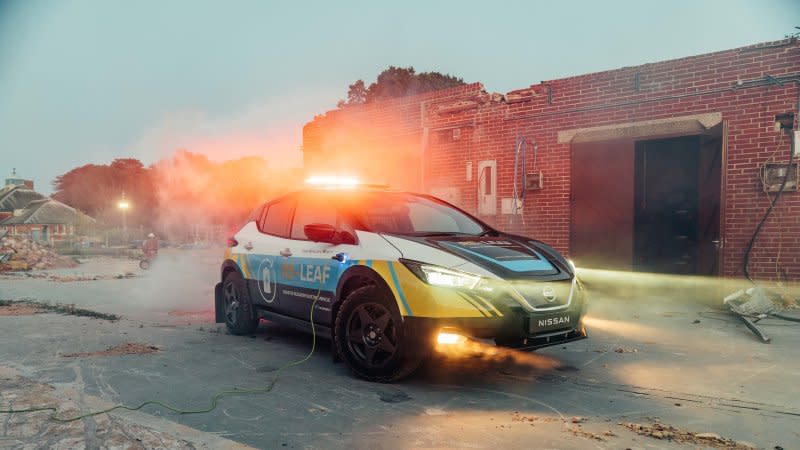Nissan's lifted Re-Leaf concept brings electricity where it's needed
Nissan put a Leaf on stilts to show how electric cars can help emergency response workers in the field. Cleverly called Re-Leaf, its latest concept was developed to deliver electricity where and when it's most needed.
Made by British race car builder RJN Motorsport, the design study is based on the Leaf Plus, which benefits from a bigger and more usable battery than the standard model. Normally, the 62-kilowatt-hour lithium-ion battery pack simply zaps the front wheels into motion. In the Re-Leaf, it can also dispense electricity via three sockets. Two are on the outside of the hatchback, under weatherproof covers, and the third is integrated into the trunk.
Nissan notes a fully-charged battery pack can power the average European household for up to six days; there's no word on how long an American household can live off of it. For example, a 230-volt, 2.6-gallon soup kettle uses 9.6 kilowatt-hours of electricity when it's plugged in for 24 hours. Running an electric jack hammer for a full day requires approximately 36 kilowatt-hours, while a 100-watt flood light consumers 2.4. In theory, the Re-Leaf can power these devices simultaneously for a day and still have enough juice left in its pack to drive home.
Its multi-tasking credentials don't end there. Instead of a rear bench, the Re-Leaf is fitted with a pull-out desk accessible by opening the hatch, and a 32-inch screen connected to the battery via a dedicated power supply. It's a setup that lets workers manage the recovery process by turning the Leaf's trunk into an operational hub.
Roads rarely remain perfectly clear during emergencies, and the Leaf is not as comfortable clearing obstacles as, say, an Armada. Nissan consequently gave the Re-Leaf about 8.8 inches of ground clearance, which is 2.7 inches more than a stock Leaf, and approximately on par with a Subaru Crosstrek. It also widened the hatchback's track, installed skid plates to protect vital underbody components, and fitted a set of BF Goodrich all-terrain tires tucked under composite fender flares. Rally-like mud flaps add a finishing touch to the look.
Nissan explained the Re-Leaf is a simple design study built to explore alternatives to the decades-old generator, and it's not planning on making the package available to customers in the near future. However, it noted even a stock Leaf can dispense electricity when properly configured, and at least 60 local government agencies in Japan have been using the hatchback to provide emergency power after black-outs since 2011. On a brighter note, the Leaf's 62-kilowatt-hour battery pack is also capable of powering a full set of Christmas lights.
You Might Also Like

 Yahoo Sports
Yahoo Sports 


